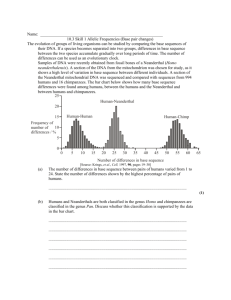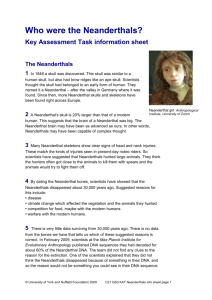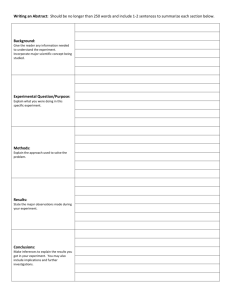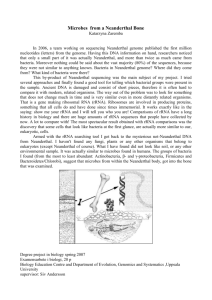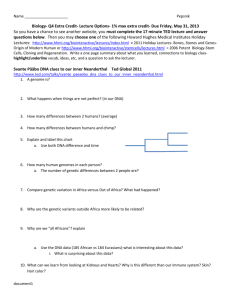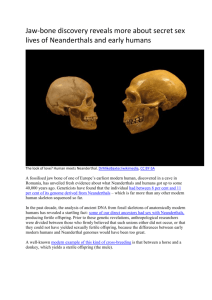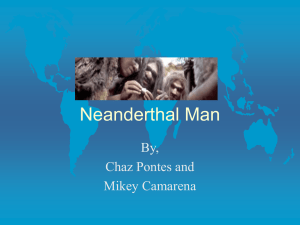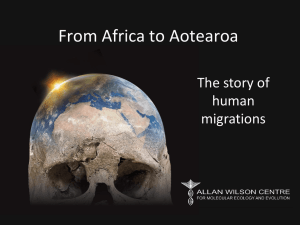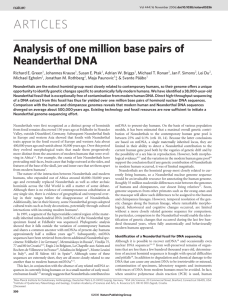December 1, 2014 - Edmonds School District
advertisement
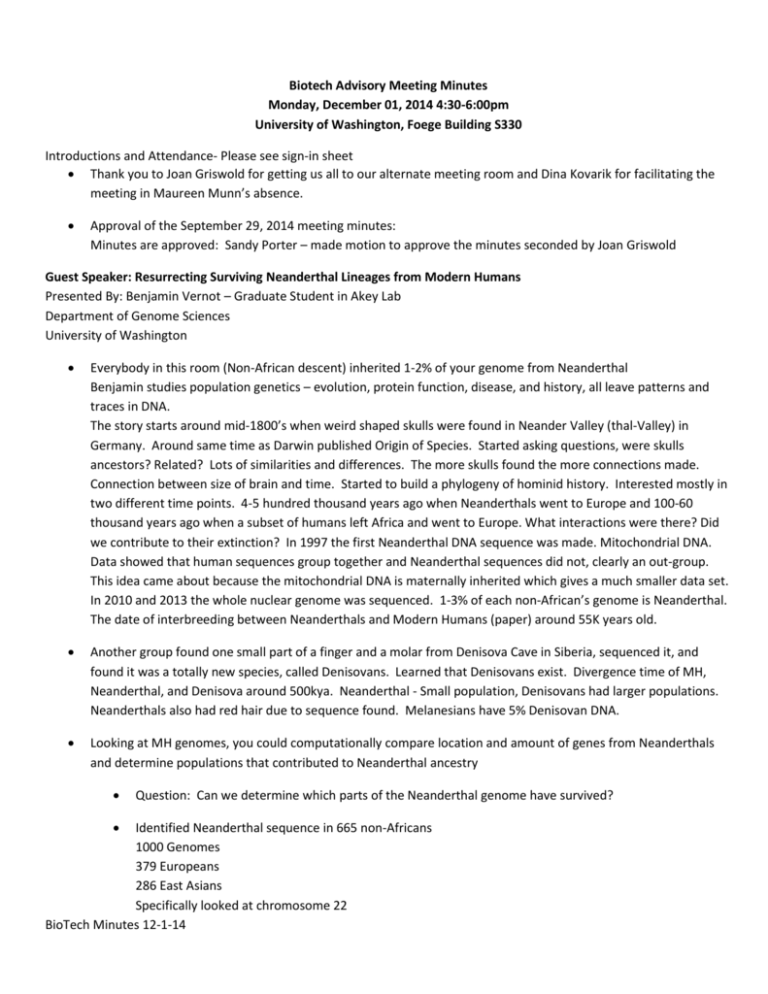
Biotech Advisory Meeting Minutes Monday, December 01, 2014 4:30-6:00pm University of Washington, Foege Building S330 Introductions and Attendance- Please see sign-in sheet Thank you to Joan Griswold for getting us all to our alternate meeting room and Dina Kovarik for facilitating the meeting in Maureen Munn’s absence. Approval of the September 29, 2014 meeting minutes: Minutes are approved: Sandy Porter – made motion to approve the minutes seconded by Joan Griswold Guest Speaker: Resurrecting Surviving Neanderthal Lineages from Modern Humans Presented By: Benjamin Vernot – Graduate Student in Akey Lab Department of Genome Sciences University of Washington Everybody in this room (Non-African descent) inherited 1-2% of your genome from Neanderthal Benjamin studies population genetics – evolution, protein function, disease, and history, all leave patterns and traces in DNA. The story starts around mid-1800’s when weird shaped skulls were found in Neander Valley (thal-Valley) in Germany. Around same time as Darwin published Origin of Species. Started asking questions, were skulls ancestors? Related? Lots of similarities and differences. The more skulls found the more connections made. Connection between size of brain and time. Started to build a phylogeny of hominid history. Interested mostly in two different time points. 4-5 hundred thousand years ago when Neanderthals went to Europe and 100-60 thousand years ago when a subset of humans left Africa and went to Europe. What interactions were there? Did we contribute to their extinction? In 1997 the first Neanderthal DNA sequence was made. Mitochondrial DNA. Data showed that human sequences group together and Neanderthal sequences did not, clearly an out-group. This idea came about because the mitochondrial DNA is maternally inherited which gives a much smaller data set. In 2010 and 2013 the whole nuclear genome was sequenced. 1-3% of each non-African’s genome is Neanderthal. The date of interbreeding between Neanderthals and Modern Humans (paper) around 55K years old. Another group found one small part of a finger and a molar from Denisova Cave in Siberia, sequenced it, and found it was a totally new species, called Denisovans. Learned that Denisovans exist. Divergence time of MH, Neanderthal, and Denisova around 500kya. Neanderthal - Small population, Denisovans had larger populations. Neanderthals also had red hair due to sequence found. Melanesians have 5% Denisovan DNA. Looking at MH genomes, you could computationally compare location and amount of genes from Neanderthals and determine populations that contributed to Neanderthal ancestry Question: Can we determine which parts of the Neanderthal genome have survived? Identified Neanderthal sequence in 665 non-Africans 1000 Genomes 379 Europeans 286 East Asians Specifically looked at chromosome 22 BioTech Minutes 12-1-14 Identified regions with very little Neanderthal ancestry and look at the distribution of size (Heterogeneous Distribution of Neanderthal Sequence). Why would those regions (deserts) no longer contain Neanderthal DNA? Did mating cause this? Were there big structural changes in the DNA? Try to look in the “deserts” for where humans could have adapted and no longer have Neanderthal DNA. Example FOXP2 gene involved in speech and language. CAPZA2 actin capping filament protein. In humans, HIC1 binding motif can suppress or activate growth (If wrong, can cause cancer). Neanderthals do not have an amino acid that allows this gene to work. If we are trying to see where we are different from Neanderthals you used to have to look at the whole genome, now can just look at the deserts. Also look at population differences. Look at amount of Neanderthal ancestry in East Asians and Europeans. East Asians have 22% more Neanderthal DNA compared to Europeans. Positive Selection: If there is a portion of Neanderthal sequence that is beneficial to humans, then we would see an increase in the frequency of DNA in the MH populations. Identified 10 regions in East Asian and European populations that have signatures of positive selections; 8 with genes, 4 play important roles in keratinocytes. Any questions/ Suggestions: Jean Ingersoll asked if it would be good to bring in an industry partner from NOAA – Gary Weinz (?) : Have a NOAA rep attend each meeting, it was mentioned that it would be OK for them to have multiple representatives that could rotate meetings if needed. Several teachers have been involved with some of their outreach work and thought this would be a good idea. Marine Mammal Genetics person was another possible person if not Gary. Jean Ingersoll will reach out to NOAA and invite them to join the advisory What other companies can we reach out to? Time to make a reach out to other companies. Announcements Shoreline Community College – Introduction to DNA workshop – DNA extraction etc. 3D models - Adrienne suggested inviting general biology teachers to attend to encourage biotech classes Claudia from ISB: - High school internships and positions will posted in January on their website. - The Dynamic DNA course will be running in the fall at a school district. Looking for a teacher to teach it which would be taught 2 hours inside the school day. Seattle biomed curriculum added. One credit for CTE Amgen Biotech Experience: Can still ask for funding the biotech experience. Amgen is looking for different ways to support teachers and the professional development within the biotech experience. Notify Dina or Adrienne with any suggestions for technique / equipment use instructional videos, useful webinars, etc. that might be useful. They have some money that can be used in the next several months toward this. Is Amgen surplusing their materials? Everything in teacher resource room at Amgen went to Shoreline Community College. Ask for specific supplies to see if they are available at Shoreline through Adrienne or Dina. Amgen may try to sell their remaining materials or contact Pierre Bedard pbedard@amgen.com (Amgen) for any available surplus BioTech Minutes 12-1-14 including office supplies. Email a wish list to Dina Kovarik dina.kovarik@gmail.com and she will see if the materials are available at Shoreline. Next Meeting: March 16th Pardip Rathad: UW Chemistry department – Working on Malaria vaccine Move to adjourn meeting: Joan moved to ajourn, Dina Kovarik seconded the motion, All members approved the motions. BioTech Minutes 12-1-14
